Exploring the Versatility of Electro-Optic Modulators in Various Applications
In today's landscape, applications in optics, photonics and pulsed lasers driven by electro-optic modulators have gained widespread recognition. A new wave of scientists is pushing the boundaries and applying these technologies across diverse fields such as lidar for automotive, medical solutions, aerospace and defense, quantum technology, and laser sensors.
Addressing testing complexities, time-to-market pressures, and the evolving demands of applications has led to the recognition of Arbitrary Waveform and Function Generators (AWG) as a state-of-the-art solution. These generators offer unparalleled flexibility, providing engineers with a powerful tool to generate a wide range of pulses, signals, and modulations.
Distinct applications call for specific signal types. Examples of AWG applications include:
- Generating high-amplitude, high-speed pulses for the direct driving of electro-optic modulators.
- Creating various signals and pulses as stimuli for quantum optics applications.
- Producing pulses to drive pulsed laser diodes.
Inner Workings of Electro-Optic Modulators
Integrated-optical waveguides, similar to optical fibers, guide light along predetermined paths. The waveguide consists of a channel with a higher refractive index than the surrounding material.

These waveguides guide light through total internal reflection at the channel walls. Single-mode operation is crucial for the functionality of integrated-optical elements, often integrated with optical fibers in communication technology.
The linear electrooptic effect, or Pockels-Effect, involves a change in the refractive index of an optical material when an external electric field is applied.
Lithium niobate (LiNbO3) is the preferred material for integrated-optical modulators due to its electrooptic response. By applying an electric field, the refractive index changes, leading to a phase shift in guided light. This allows for modulation at high frequencies in the gigahertz range.



Inserting a phase modulator into an integrated Mach-Zehnder interferometer forms an amplitude modulator. Applying a voltage induces a relative phase difference, controlling the device's transmission between minimum and maximum values. The Arb Rider AWG-5000 Arbitrary Waveform Generator facilitates the creation of modulation voltages with very narrow pulses, directly driving electro-optical modulators without external amplification.
A phase modulator integrated into a Mach-Zehnder interferometer forms an amplitude modulator.
Applying voltage induces a relative phase difference, controlling the device's transmission between minimum (Pmin) and maximum (Pmax) values. The half-wave voltage (Vπ) determines the switching states, with the amplitude modulator's push-pull operation requiring half the voltage of a phase modulator. For instance, it is anticipated to be 1.5 V in the red spectrum at 635 nm and 5 V in the telecommunications wavelength range around 1550 nm.


Harnessing AWG for Electro-Optic Modulation
When an RF signal is applied as a modulation voltage to the electrodes, this electrical input is translated into amplitude information.
This amplitude output depends on the magnitude and shape of the voltage and is therefore related to the position of the modulator operating point. The figure shows the conversion of a binary pulsed electrical input into a binary optical output signal. If the voltage levels are not correct, i.e. the voltage is too high or the offset is incorrect, the modulator will respond with incorrect optical output levels in binary operation or with higher harmonics in analogue operation.

 (Image Source: Active Technologies)
(Image Source: Active Technologies) Pulsed Laser
Active Technologies' AWG-5000 Arbitrary Waveform Generators allow you to generate modulation voltage by producing very narrow pulses (minimum pulse width 230 ps) up to 5Vpp.
The high amplitude output, combined with a 110 ps rise/fall time (5 Vpp @ 2 GHz bandwidth), allows you to directly drive various types of electro-optic modulators without the need for an external amplifier.

It is easy to generate different pulse shapes for greater control of the optical output signal, thanks to the True ARB user interface.
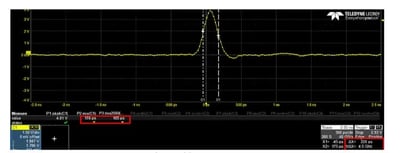
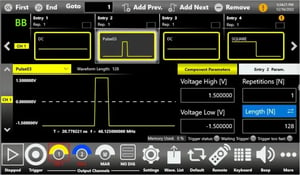
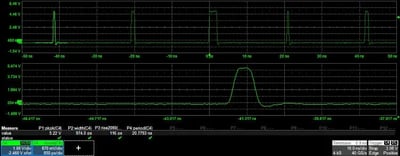
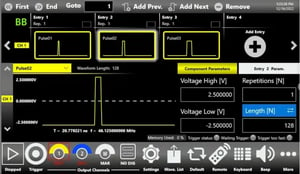
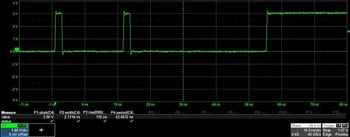

+++ NEW +++
Discover why the latest model of the ARB Rider AWG Series AWG-7000 is the ideal choice for cutting-edge research challenges in the fields of Quantum Computing, Communication & Encryption and Sensing, Optics & Photonics, High Energy Physics, Semiconductor Test and RF Wireless Communication.
The ARB Rider AWG-7000 offers the world’s fastest 14 Bit Arbitrary Waveform Generator with an update rate of 20 GS/s, 5 Vpp output voltage range, 50ps rise/fall time, and up to 9 GSamples memory depth.
Available in 2 or 4 channel models, the AWG-7000 is reaching up to 10 GHz output frequency and its intra-chassis synchronization bus allows to extend to 16 synchronized analog channels and 128 digital channels for the most powerful mixed signal generator in the world. Thanks to the free and easy-to-use Simple Rider software, the AWG-7000 allows to easily generate the most complex analog and digital signals for your research projects.
How to use the True-Arb AWG Software
Connect with Our Experts
If you have any further inquiries or need assistance with a tailored solution for your specific needs, please reach out to our team of experts. We are committed to providing comprehensive support to ensure your success.


